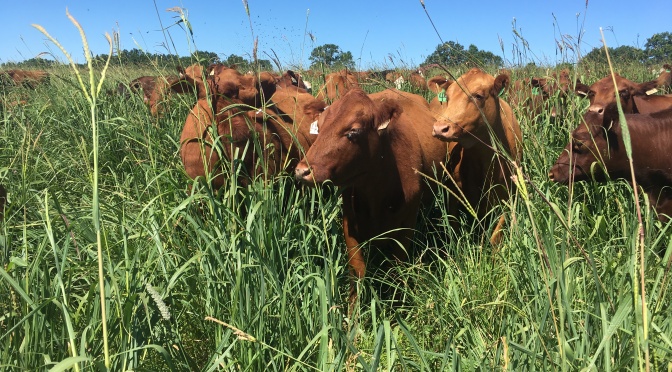Oftentimes, it is a practice to have two calving seasons – one in the spring and one in the fall. Dr Dick Diven gave thought to the idea that in north Missouri or other areas where the predominant cool season grass is the non-native toxic endophyte fescue, fall calving might be better than spring due to some believing the toxic effects would be reduced. The observed symptoms may be reduced since the outside temperatures are typically lower thereby giving the heat stressed cattle some relief from the vaso-constricting properties of the toxic endophyte. However, our extensive results on this practice show no advantage as far as reproductive improvement or increased production. Fall calving does, however, increase winter costs due to calving out of sync with the growing season. Keeping nursing pregnant cows in condition on stockpile grasses or hay is difficult and expensive. Additionally, having two separate breeding seasons adds considerably to the labor component.
Some ranchers choose to incorporate both seasons by allowing cows which come up open (not pregnant) in one season to dropping them into the following season vs selling her or holding it until the next spring calving season. On the face of it, this may sound wise.
Consider:
- Without very careful written records, a cow can easily be rolled into each subsequent season without ever having a calf!!
- Replacement heifers or, worse, keeping a bull calf, out of a cow which has missed, but you don’t know it can lead to devasting long term reproductive problems in the herd at large. Cows that calve only every other year may keep her good condition and wean a nice-looking calf, but she is not profitable if given a pass every year or two or more!
- Having two calving seasons means two times of hauling the bulls out to every single cow TWICE! And getting them back in. Pregnancy checking then reveals, that there will be spring calving cows and fall calving cows in all the various herds. In our case, there are eight herds of cows!
- Cows will be sorted at preg check as to fall or spring calvers, then hauled to whichever location has that group. Labor, labor, labor. There is always the possibility of a mistake and a fall calver ends up with spring calvers or vice versa. Total pain in the rear.
- Two weaning times adds to stress and labor and incurs a less uniform calf crop.
- Does not result in fewer open cows, but it does allow slackers to slip through by giving them multiple chances to ever breed and calve.
Without careful records, regardless of how you choose to manage the seasons, the risk is great that a cow can grow old without ever bringing in a ticket. Cows often will preg check carrying a calf, but either abort or lose the calf at some point. Can anyone afford to keep such an animal? Flipping cows from one season to the next greatly increases the chances that a cow will slip through.
In my opinion, calving in one season only, spring (May-June) – not winter – and have all cows in one herd – two at the most. This drastically reduces labor and then number of bulls one needs to cover the cows.
In this day and age of huge expense increases, written records are key, making culling decisions based on those records, imperative, selecting only adapted animals to grow your herd is a must. (records should include observing and recording which cows pant or stand in the pond or ditch, don’t slick off in the summer, those which can’t take the cold and stress of mud, humidity, flies, or whatever challenges are in your environment). Many of these observations will be revealed by cows coming up open or dead. Better to minimize either by eschewing purchasing unadapted animals and hoping they will adapt. The vast majority will not.


